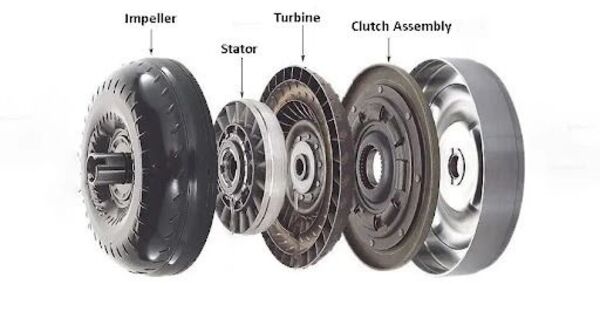A torque converter is a device, typically implemented as a fluid coupling, that transmits rotating power from a prime mover, such as an internal combustion engine, to a rotating driven load. It is a component in automatic transmissions that functions similarly to a clutch in manual transmissions. It transfers power from the engine to the transmission input shaft.
In a vehicle with an automatic gearbox, the torque converter connects the prime mover to the automatic gear train, which drives the load. It is thus typically found between the engine’s flexplate and the transmission. A manual transmission’s analogous device is the mechanical clutch.
Here’s how it works:
- Fluid Coupling: A torque converter is built around a fluid coupling, which consists of an impeller (connected to the engine), a turbine (connected to the transmission input shaft), and a stator (which redirects fluid flow). This fluid coupling facilitates the passage of power from the engine to the transmission.
- Fluid Dynamics: When the engine is running, the impeller inside the torque converter spins, forcing the transmission fluid to flow. This fluid flows towards the turbine, causing it to spin as well. The stator directs the fluid so that it flows more efficiently back to the impeller, increasing torque output.
- Torque Multiplication: One of the key features of a torque converter is torque multiplication. When the vehicle is at a standstill or moving slowly, the turbine can spin faster than the impeller due to the fluid dynamics within the torque converter. This multiplication of torque allows the vehicle to accelerate more quickly.
- Lock-up Clutch: To improve fuel efficiency and reduce heat generation, modern torque converters often incorporate a lock-up clutch. This clutch mechanically connects the impeller and turbine once the vehicle reaches a certain speed, eliminating the fluid coupling and reducing slippage. This makes the transmission more efficient, similar to how a manual transmission operates when the clutch is engaged.
A torque converter increases transmitted torque when the output rotational speed is low. In the fluid coupling embodiment, a fluid is driven by the vanes of an input impeller and directed through the vanes of a fixed stator to drive an output turbine in such a way that torque on the output increases when the output shaft rotates slower than the input shaft, resulting in the equivalent of an adaptive reduction gear.
This is a feature that goes beyond what a simple fluid coupling offers, which can match rotational speed but not multiply torque. Fluid-coupling-based torque converters often have a lock-up capability to tightly couple input and output, avoiding the efficiency losses associated with transmitting torque via fluid flow when operating conditions allow.
Overall, torque converters play an important part in the smooth running of automatic transmissions by providing the torque multiplication and fluid coupling required for effective power transfer between the engine and transmission.
















